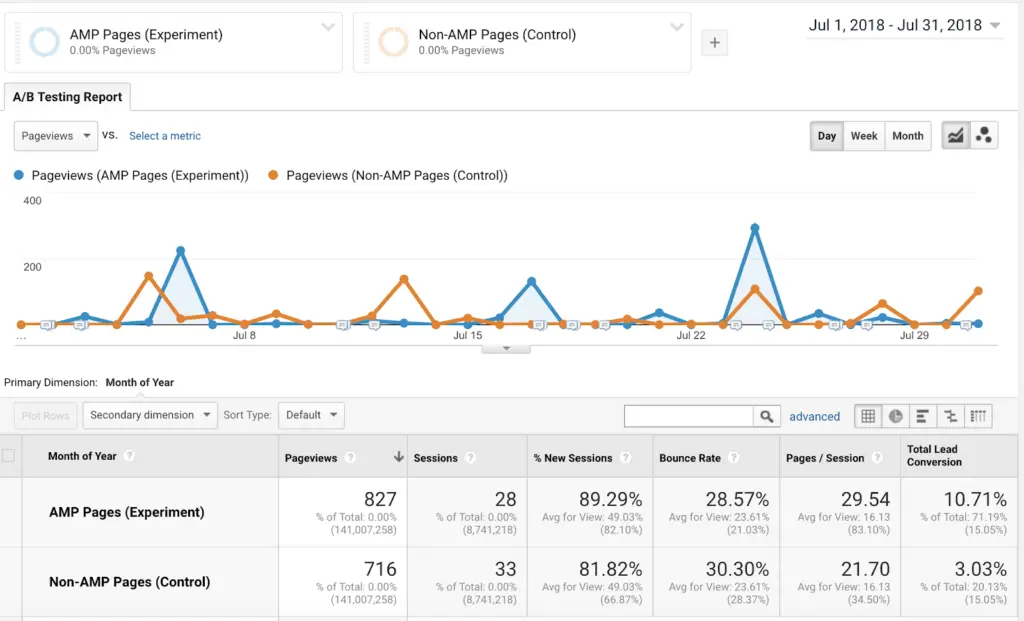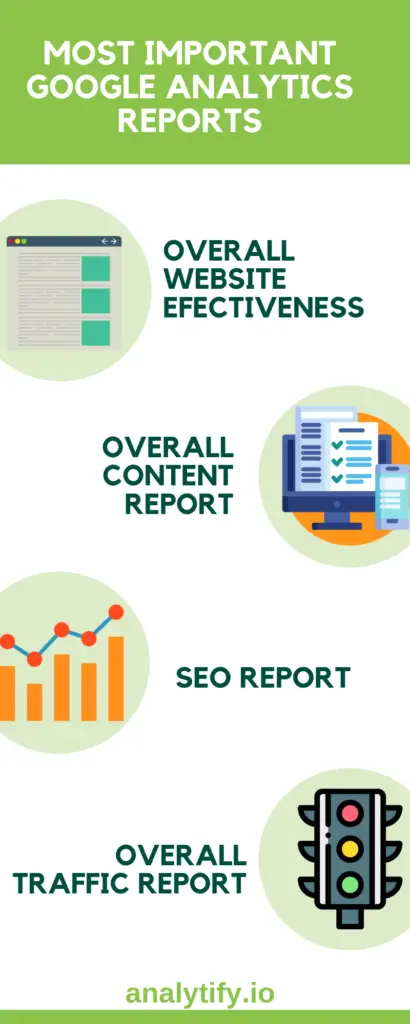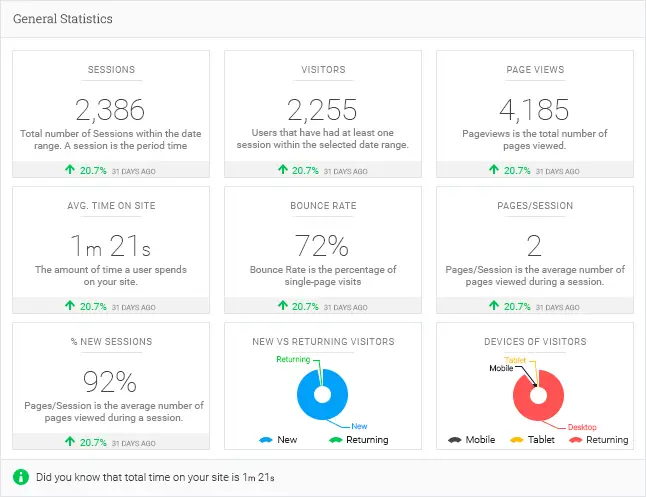
Most Important Google Analytics Reports For WordPress Site
The number of WordPress Websites serving the same market segment is growing every day. The competition is growing harder every second. Only those Websites will stay afloat and retain their market segment who can exploit their strengths properly.
And in order to identify your strength, you need data. Like so many people, you might also be using Google Analytics, but the question is are you checking the most important google analytics reports?
This blog covers four aspects of analyzing how good your Website is by analyzing the Most Important Google Analytics Reports. The first step is to see how effective your Web-Pages are. The second step involves checking how good your Website content is. And the last two steps involve analyzing SEO and Traffic. So let’s get started.
Most Important Google Analytics Reports For WordPress Site
Overall Website Report
The first Most Important Google Analytics Reports give an overall view of the effectiveness of the different Web pages on your Website.
- Browser Report
Your Website must look the same when accessed via different browsers. There are a lot of popular browsers E.g Chrome, Firefox, Opera, Safari.
Moreover, along with using different browsers, your users can also be accessing your website via a different array of devices like their laptops, smartphones, or Tabs. Regardless of the browser and device, they are using, they must always see the best version of your website.
Stats to look for in the report-
- Operating System the user is using.
- Browser the user is using.
- Browser Version the user is using.
- Identify slow loading pages
Every report in Analytics is made up of dimensions and metrics. Dimensions are attributes of your data. For example, the dimension City indicates the city, for example, “Paris” or “New York”, from which a session originates. The dimension Page indicates the URL of a page that is viewed.
Metrics are quantitative measurements. The metric Sessions is the total number of sessions. The metric Pages/Session is the average number of pages viewed per session.
- Mobile Performance Report-Google AMP Reports
Why are we including a separate section in our blog for Mobile Devices? Well, it’s because at present Smartphone is the number one tool for accessing the internet. Currently, 2.9 Billion people have a Smartphone, and this figure is only going to grow.
Another advanced stats for mobile devices is AMP reports. If you are putting in the effort to make your Web-Pages AMP compliant, you should also be checking how they are performing.
As Google Analytics like wrote in one of their Docs, accessing AMP compatibility should be a thought exercise to define what content we are going to compare in the final report. For a given page type (ex: article, category, or product detail page), identify two groups of pages with similar metrics for visits, bounce rate, and conversions:
- AMP Experiment Group: The ‘AMP Experiment’ group of URLs has the AMP URLs that have launched and are discoverable via Google Search.
- Non-AMP Control Group: The ‘Non-AMP Control’ group contains URLs that don’t have any AMP equivalent. These URLs should perform similarly to URLs that do have an AMP version.
After you have the two groups you should be looking into the following metrics-
- Pageviews
- Sessions
- % New Sessions
- Bounce Rate
- Top Exit page and Landing Page
You might have multiple Web-Pages on your website- Home Page, Clients, Team Member Page, Testimonial Page, Pricing Page. A site-visitor might visit all the web pages once they land on your Websites. However, apparently, the more important figure to be looking at is the Landing Page and Exit Page. Once you know these two points of the journey your users take, you can modify your marketing campaigns.
Before you read the stats, you should ask yourself what is the web-page on your website you intentionally want to be the Landing Page and Exit page. Once you have that plan, you check the actual results and decide where improvement is needed. The point of having this plan is, people aren’t gonna spend a lifetime on your website, they will leave at one point. But what will be that point is something you can control.
User Flow Report
Check the Users Flow report is the most Important Google Analytics Reports. It provides a graphical representation of the paths users took through your site, from the source, through the various pages, and where along their paths they exited your site. The Users Flow report lets you compare volumes of traffic from different sources, examine traffic patterns through your site, and troubleshoot the efficacy of your site. Analytics provides a number of specialized flow reports.
- Behavior Flow– The Behavior Flow report visualizes the path users traveled from one Page or Event to the next.
- Goal Flow– The Goal Flow report shows the path your traffic traveled through a funnel towards a Goal conversion.
- Users Flow– The Users Flow report compares volumes of traffic from different sources, letting you examine traffic patterns through your site.
- Events Flow– The Events Flow report lets you visualize the order in which users trigger Events, such as video plays, file downloads, and interacting with embedded gadgets.
- Funnel Visualization– The Funnel Visualization report gives you an overview of the selected Goal conversion funnel.
- Google Play Referral Flow– The Google Play Referral Flow report helps you gauge interest in your app by showing you the volume of traffic through each stage of the acquisition process.
Overall Content Report
The Second Most Important Google Analytics Reports give an overview of the quality of content on your Website.
After you have gone through the Web Page Performance stats, you should be looking at your Content.
Content is like a treasure. Your site-visitors look for value in your content. The better the quality of your content, the better. Two key outcomes you should be expecting after going through your content reports is-Identify the subject matter that best works for you and content elements (Video, Photo, infographics)
There is a bundle of four content reports you should check regularly.
- All Pages Report
This report includes metrics such as Pageviews, Unique Pageviews, Avg. Time on Page, Entrance, Bounce Rate, % Exit, Page Value.
- Content Drill-down
Use this report to check the overall view of the different parts of a website. The reports groups pages based on their sub-directories and provides the same measurement metrics as the All Pages Report.
- Landing Page
This Report is the most Important Google Analytics Report to see which Web-Page and for how many times was the first visited page of a session. Along with these figures, it also provides metrics such as %New Session, New Users, Bounce Rate, Average Session Duration.
- Exit Page
This report includes figures about what Web-Page and how many times was the last visited page of a session. This most Important Google Analytics report also provides reports on Page views, %Exits.
A quick and easy hack for improving content is checking the Title of the highest-viewed and lowest-viewed page.
SEO Report
The third Most Important Google Analytics Reports gives an overview of the quality of your SEO.
SEO might not be the most important metric for Online Marketing, but a good SEO score means you are ranking high for your targeted keywords.
- Check Organic Search Metrics.
You might get traffic to your website via a lot of mediums. But to evaluate the SEO performance, you need to understand how good your SEO marketing is going. To see this report first navigate to Acquisition > All Traffic > Channels. Once there click on the Organic Search tab to see results for only organic traffic.
- Check Assisted Conversions for checking the quality of the SEO.
You might target new key-words each month. But how do you evaluate whether or not the new keywords are improving your overall SEO quality? You do it by checking the Assisted Conversions. This report is great for evaluating the overall increase and decrease in traffic.
Traffic Analysis
The fourth Most Important Google Analytics Reports gives an analysis of the traffic to your website.
It is best for picking a fixed time for publishing regular posts on your WordPress Blog. Referring Sites Report is also helpful to identify the Website that refers to you. You might want to go into an affiliation with them. Which country
- Custom Segment
Using Google Analytics you can segment the audience based on any of the dimensions such as time on site, location, device used. For a more in-detail overview of the segment navigate to Audience > Interests > Overview. From here you can see the three interest reports- Affinity Categories, In-Market Segments, Other Categories.
- Traffic Acquisition from Social Media Report
Social Media is now a big player in terms of distributing traffic. You might have a big chunk of your overall site visitors coming from social media.
Wrapping Up!
In conclusion, we would like to talk about another important aspect of the Google Analytics report, Form Conversion. Although every Form Plugin for WordPress gives you the option of checking how fast you are growing your mailing-list. But it’s always better to save the stats as you are evaluating other aspects of your site performance. It will save you a lot of time.
Talking about saving time, how great would it be if you can see your Google Analytics Reports from WordPress Dashboard.
Analytify for Google Analytics is the ideal solution for bringing in all the Google Analytics stats inside your WordPress Dashboard.
This plugin presents all Google Analytics stats in an easy-to-understand manner so that not-so-tech-savvy individuals can also interpret the results in a meaningful way.
In case you have an online store, Analytify also has you covered. It will give you stats about n what stage people are leaving the cart, where are they coming from, how much money you are generating, and so on.
And lastly, Analytify can be seen as your go-to solution. Once you get best Google Analytics Plugin http://analytify.io/Analytify, you can opt-in to receive emails containing the Google Analytics Reports. That way, no matter where you are, and at times when you can’t access your website’s back end, you can check up on your Google Analytics Reports via Emails.











